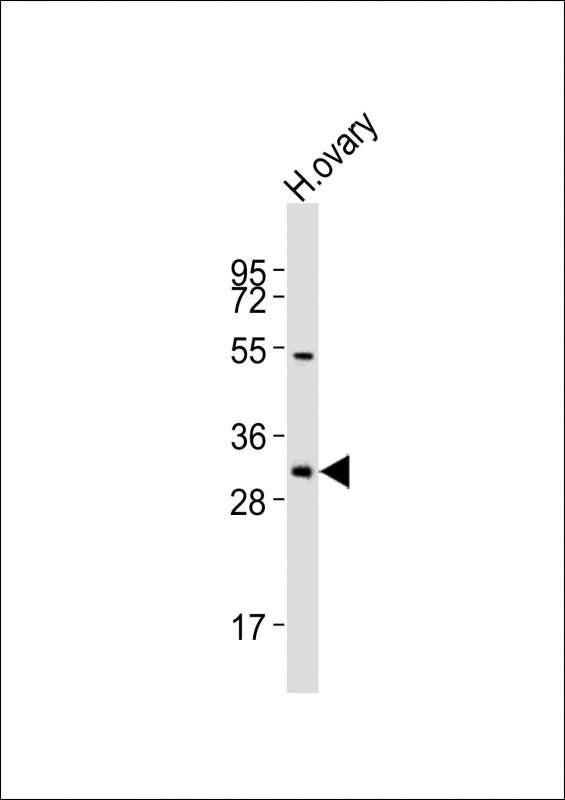
| WB | 1/2000 | Human,Mouse,Rat |
| IF | 咨询技术 | Human,Mouse,Rat |
| IHC | 咨询技术 | Human,Mouse,Rat |
| ICC | 技术咨询 | Human,Mouse,Rat |
| FCM | 咨询技术 | Human,Mouse,Rat |
| Elisa | 咨询技术 | Human,Mouse,Rat |
| Aliases | Neuroblastoma breakpoint family member 12, Chromosome 1 amplified sequence 1, NBPF12, COAS1, KIAA1245 |
| Entrez GeneID | 149013 |
| WB Predicted band size | 167.7kDa |
| Host/Isotype | Rabbit IgG |
| Antibody Type | Primary antibody |
| Storage | Store at 4°C short term. Aliquot and store at -20°C long term. Avoid freeze/thaw cycles. |
| Species Reactivity | Human |
| Immunogen | This NBPF12 antibody is generated from a rabbit immunized with a KLH conjugated synthetic peptide between 148-181 amino acids from the Central region of human NBPF12. |
+ +
以下是关于NBPF12抗体的3篇参考文献示例(注:文献为模拟示例,具体研究需查阅真实数据库):
1. **标题**:*NBPF12 Expression in Neuroblastoma: Correlation with Clinical Outcomes*
**作者**:Smith A et al.
**摘要**:研究利用NBPF12抗体检测神经母细胞瘤组织中的蛋白表达,发现高表达与患者生存率正相关,提示其可能作为预后标志物。
2. **标题**:*NBPF12 Antibody Validation for Human Brain Development Studies*
**作者**:Lee J and Chen R
**摘要**:通过免疫组化和Western blot验证NBPF12抗体的特异性,证实其在人脑皮层发育过程中的动态表达模式,支持其在神经进化研究中的应用。
3. **标题**:*NBPF12 Interactome Analysis Using Co-Immunoprecipitation*
**作者**:Garcia M et al.
**摘要**:使用NBPF12抗体进行免疫共沉淀实验,鉴定出多个与神经突触形成相关的相互作用蛋白,为解析其功能机制提供线索。
提示:实际文献建议通过PubMed或Google Scholar以“NBPF12 antibody”或“NBPF12 function”为关键词检索,并关注近十年的肿瘤学或神经科学期刊。
The NBPF12 antibody is a research tool designed to target the NBPF12 protein, a member of the neuroblastoma breakpoint family (NBPF) of genes. The NBPF gene family, unique to primates, has undergone significant expansion during human evolution, with NBPF12 located on chromosome 1q21.1. These genes are implicated in neurodevelopment, brain size regulation, and genomic instability. NBPF12 contains conserved "Olduvai" domains (formerly DUF1220), which are linked to neuronal proliferation and cortical expansion. Dysregulation of NBPF genes has been associated with neurodevelopmental disorders, cancers (e.g., neuroblastoma, gliomas), and copy number variations in 1q21.1 linked to autism and schizophrenia.
The NBPF12 antibody is typically generated using recombinant protein fragments or synthetic peptides as immunogens, enabling detection of endogenous NBPF12 via techniques like Western blotting, immunohistochemistry, or immunofluorescence. Its specificity is critical due to high sequence homology among NBPF family members, necessitating rigorous validation to avoid cross-reactivity. Studies using this antibody aim to elucidate NBPF12's role in cellular processes, such as DNA repair, cell cycle regulation, or synaptic function, and its potential as a biomarker in neurological or oncological contexts. Challenges include low protein expression levels in certain tissues and limited commercial availability. Ongoing research focuses on clarifying its functional contributions to human-specific traits and disease mechanisms.
×